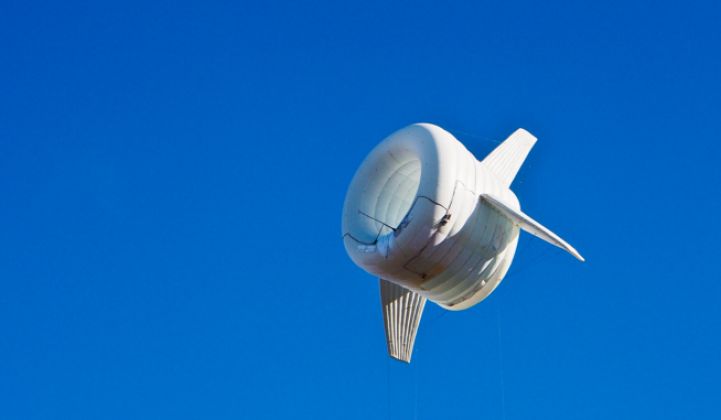The Japanese telecommunications powerhouse SoftBank Corp. announced yesterday it will invest $7 million in Altaeros Energies Inc. to support commercial development of the startup’s high-flying wind turbine technology.
High-altitude wind turbines are designed to produce clean energy by harnessing the stronger, more consistent winds thousands of feet above the ground. The technology has been in development for years, but has only recently started to take off.
Altaeros’ Buoyant Air Turbine (BAT), born out of the Massachusetts Institute of Technology, resembles a donut-shaped inflatable playpen. A circular helium-filled shell is used to float the turbine 1,000 to 2,000 feet in the air, where it’s expected to generate more than twice the energy of a similarly sized tower-mounted turbine. High-strength tethers adapted from the aerospace industry lift the system and send electricity to ground.
Since Altaeros was formed in 2010, it has developed four prototypes with the help of government grants, competitive awards and a small group of angel investors, including a company owned and controlled by Ratan Tata, former chairman of the Tata Group, which is heavily involved in of wind energy projects in India. SoftBank’s investment is Altaeros’ first significant round of funding.
Chairman and CEO of SoftBank Masayoshi Son, who holds the title of richest man in Japan, developed a keen interest in clean energy technologies in the wake of the Fukushima Daiichi nuclear disaster. In 2011, SoftBank launched a major renewable energy business unit, SB Energy Corp., to promote the expansion of safe renewable energy in Japan.
The easily transportable design of the BAT makes it uniquely capable to operate in locations with limited or no access to the grid, including island communities, military bases, far-flung industrial sites and disaster zones.
“Altaeros' airborne wind turbine technology is a new and promising renewable energy solution for remote islands and locations in Japan and the Asia‐Pacific region,” said SoftBank’s Son in a statement.
In addition to providing a supply of clean, resilient energy, BAT can be used to lift other equipment into the air for surveillance or telecommunications services, such as broadband internet. This could create new business opportunities for both Altaeros and SoftBank, which is the second-largest wireless carrier in Japan and parent to the U.S. company Sprint.
“Since telecommunications is an important hybrid service of our product, having a partner like SoftBank that is a leader in telecommunications is a very good fit for us,” said Adam Rein, co-founder of Altaeros. “Particularly since our focus is expanding our services to remote or off-grid island regions that aren’t well serviced today.”

According to Rein, SoftBank’s $7 million investment goes beyond financial support. The company will also serve as a strategic partner, although the terms have not yet been set. Early-stage startups often struggle with whether to target strategics or venture capital firms as sources of funding.
A portion of the funds will go toward the deployment of Altaeros’ first commercial-scale pilot of a 30-kilowatt BAT unit near Fairbanks, Alaska. Roughly half of the $1.3 million, eighteen-month project was financed by the Alaska Energy Authority. The project is now caught up in a slow permitting process, but Altaeros hopes to have it operational by the end of next year.
The company has set a near-term price target of 18 cents per kilowatt hour, which is well above the 5 cents per kilowatt-hour that large-scale projects can get in windy places like West Texas. But Altaeros isn’t competing with the traditional electric grid market, said Rein. It’s targeting those remote locations where energy costs can spike up to 25 cents per kilowatt-hour.
Also, like other technologies such as solar PV, the company is actively engaged in an effort to bring costs down over time.
Altaeros isn’t the only company trying to develop a flying wind turbine. In 2010, we reported on Honeywell’s design for an airborne wind turbine modeled on military technology. NASA engineers have been developing a kite-like wind energy device to access wind energy at higher altitudes. The startup Makani Power that was acquired by Google X last year is also developing an energy kite, which could have some technical overlap with Google’s Project Loon.
Makani Power announced this fall it will begin testing its technology on Hawaii’s Big Island in 2015. Recent investments in European airborne wind energy companies have also added momentum to the industry, including 3M’s funding of Nature Technology Systems, DSM Venturing’s funding of SkySails, KLM Royal Dutch Airlines’ funding of Ampyx Power, and Sabic Ventures’ funding of KiteGen.
The sector has enormous growth potential. According to a Stanford University paper, the total energy from high-altitude winds is enough to power the world 100 times over. Of course, only a small portion of that wind is likely to be tapped due to technical and cost constraints.
“But it can help open people’s imaginations to how extending turbines to five times higher than conventional turbines could unlock a whole new energy resource that hasn’t been tapped before,” said Rein.



